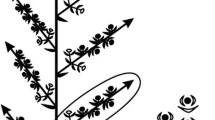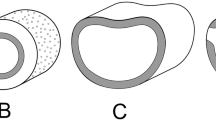Summary
This study of the floral nectary ofVicia faba L. focusses on the modified stomata through which nectar flows, and on the question of whether they can regulate their stomatal pore aperture. The floral nectary ofV. faba consists of a disk which surrounds the gynoecium. As the flower bud matures, a tapered projection arises by cell divisions and expansion at a position opposite the free stamen. Modified stomata develop from pentagonal guard mother cells on this projection, and are often contiguous, but because development of modified stomata is asynchronous, many stages can occur in a local area. Plasmodesmata, which connect guard mother cells and guard cells of developing modified stomata with adjacent cell types, become covered by cell wall material on the guard-cell side in mature modified stomata. The numerous small vacuoles of guard mother cells and young guard cells are replaced by a single large one as the guard cells expand. Pore development occurs concurrent with this expansion as the ventral walls separate at a designated location leading to rupture of the inner, and then outer, cuticles, to reveal the pores of mature modified stomata.
The stomata are considered to be “modified” because the guard cells of mature stomata only rarely can contract sufficiently to close their pores. Several structural features may contribute to this inability to close the pores by guard-cell movements: a cuticle which lines all free surfaces of guard cells; ridges of circumferentially-arranged microfibrils along the outer (and sometimes inner) walls; an unidentified osmiophilic wall material. Pores of modified stomata reach their maximum mean aperture dimensions a few days before the onset of secretion. Also, open, and even immature, modified stomata occur on old post-secretory glands undergoing degradation. Together with their inability to regulate, the lack of close correlation between development of modified stomata and secretion suggest that nectar flow is not finely regulated by these structures.
Although there is no evidence for regulation of pore aperture, pores may become occluded. In these cases, an osmiophilic material, released through channels in the cuticle of outer and ventral walls, is deposited across the pore as a film. Although occluded pores can occur on very young buds, they are more common on secretory or post-secretory nectaries.
Similar content being viewed by others
Abbreviations
- GC:
-
guard cell
- GMC:
-
guard mother cell
- MS:
-
modified stomata
- SEM:
-
scanning electron microscopy
- TEM:
-
transmission electron microscopy
References
Allaway WG, Setterfield G (1972) Ultrastructural observations on guard cells ofVicia faba andAllium porrum. Can J Bot 50: 1405–1413
Belin-Depoux M (1989) Des hydathodes aux nectaires foliaires chez les plantes tropicales. Bull Soc Bot Fr 136: 151–168
Bonnier G (1879) Les nectaires-étude critique, anatomique et physiologique. Ann Sci Nat Bot 8: 5–212
Carr DJ, Carr SGM, Jahnke R (1980) Intercellular Strands associated with stomata: stomatal pectic strands. Protoplasma 102: 177–192
Collison CH, Martin EC (1975) A scanning electron microscope study of cucumber nectaries,Cucumis sativus. J Apic Res 14: 79–84
Daumann E (1974) Zur Frage nach dem Vorkommen eines Septalnektariums bei Dicotyledonen. Preslia (Praha) 46: 97–109
Davis AR, Gunning BES (1991) The modified stomata of the floral nectary ofVicia faba L. 2 Stomatal number and distribution as selection criteria for breeding for high nectar sugar production. Acta Horticult 288: 329–335
—, Peterson RL, Shuel RW (1988) Vasculature and ultrastructure of the floral and stipular nectaries ofVicia faba (Leguminosae). Can J Bot 66: 1435–1448
Elias TS, Gelband H (1977) Morphology, anatomy, and relationship of extrafloral nectaries and hydathodes in two species ofImpatiens (Balsaminacaeae). Bot Gaz 138: 206–212
Eriksson M (1977) The ultrastructure of the nectary of red clover (Trifolium pratense). J Apic Res 16: 184–193
Fahn A (1979) Secretory tissues in plants. Academic Press, New York
Frey-Wyssling A, Häusermann E (1960) Deutung der gestaltlosen Nektarien. Ber Schweiz Bot Ges 70: 150–162
Galatis B, Mitrakos K (1980) The ultrastructural cytology of the differentiating guard cells ofVigna sinensis. Amer J Bot 67: 1243–1261
—, Apostolakos P, Katsaros C, Loukari H (1982) Pre-prophase microtubule band and local wall thickening in guard cell mother cells of some Leguminosae. Ann Bot (London) 50: 779–791
Galway ME, McCully ME (1987) The time course of the induction of callose in wounded pea roots. Protoplasma 139: 77–91
Gunning BES, Hughes JE (1976) Quantitative assessment of symplastic transport of pre-nectar into the trichomes ofAbutilon nectaries. Aust J Plant Physiol 3: 619–637
—, Steer MW (1975) Plant cell biology -an ultrastructural approach. Edward Arnold, London
Jensen WA (1962) Botanical histochemistry: principles and practice. WH Freeman, San Fransisco
Lurie S (1977) Stomatal development in etiolatedVicia faba: relationship between structure and function. Aust J Plant Physiol 4: 61–68
Mace ME (1963) Histochemical localization of phenols in healthy and diseased banana roots. Physiol Plant 16: 915–923
Maeda E, Maeda K (1987) Ultrastructural studies of leaf hydathodes. I. Wheat (Triticum aestivum) leaf tips. Jap J Crop Sci 56: 641–651
Marin JA, Gella R, Herrero M (1988) Stomatal structure and functioning as a response to environmental changes in acclimatized micropropagatedPrunus cerasus L. Ann Bot (London) 62: 663–670
Mortlock C (1952) The structure and development of hydathodes onRanunculus fluitans Lam. New Phytol 51: 129–138
O'Brien TP, McCully ME (1981) The study of plant structure-principles and selected methods. Termarcarphi, Melbourne
Palevitz BA, Hodge LD (1984) The endoplasmic reticulum in the cortex of developing guard cells: coordinate studies with chlorotetracycline and osmium ferricyanide. Dev Biol 101: 147–159
Pallas JE, Mollenhauer HH (1972a) Physiological implications ofVicia faba andNicotiana tabacum guard-cell ultrastructure. Amer J Bot 59: 504–514
— — (1972b) Electron microscopic evidence for plasmodesmata in dicotyledonous guard cells. Science 175: 1275–1276
Pearson CJ, Milthorpe FL (1974) Structure, carbon dioxide fixation and metabolism of stomata. Aust J Plant Physiol 1: 221–236
Peterson RL, Firminger MS, Dobrindt LA (1975) Nature of the guard cell wall in leaf stomata of threeOphioglossum species. Can J Bot 53: 1698–1711
Picklum WE (1954) Developmental morphology of the infloresence and flower ofTrifolium pratense L. Iowa State Coll J Sci 28: 477–495
Power MS, Skog JE (1987) Ultrastructure of the extrafloral nectaries ofPteridium aquilinum. Amer Fern J 77: 1–15
Reeve RM (1950) Histochemical tests for polyphenols in plant tissues. Stain Tech 26: 91–96
Sammataro D, Erickson EH, Garment MB (1985) Ultrastructure of the sunflower nectary. J Apic Res 24: 150–160
Sanchez SM (1977) The fine structure of the guard cells ofHelianthus annuus. Amer J Bot 64: 814–824
Singh AP, Srivastava LM (1973) The fine structure of pea stomata. Protoplasma 76: 61–82
Spurr AR (1969) A low-viscosity epoxy resin embedding medium for electron microscopy. J Ultrastruct Res 26: 31–43
Steer MW (1981) Understanding cell structure. Cambridge University Press, London
Stevens BP (1956) The structure and development of the hydathode ofCaltha palustris L. New Phytol 55: 339–345
Taiz L (1984) Plant cell expansion: regulation of cell wall mechanical properties. Annu Rev Plant Physiol 35: 585–657
Teuber LR, Albertsen MC, Barnes DK, Heichel GH (1980) Structure of floral nectaries of alfalfa (Medicago saliva L.) in relation to nectar production. Amer J Bot 67: 433–439
Venable JH, Coggeshall R (1965) A simplified lead citrate stain for use in electron microscopy. J Cell Biol 25: 407–408
Waddle RM, Lersten NR (1973) Morphology of discoid floral nectaries in Leguminosae, especially tribe Phaseoleae (Papilionoideae). Phytomorphology 23: 152–161
Webster BD, Ross RM, Evans T (1982) Nectar and the nectary ofPhaseolus vulgaris L. J Am Soc Hort Sci 107: 497–503
Wille AC, Lucas WJ (1984) Ultrastructural and histochemical studies on guard cells. Planta 160: 129–142
Williams MH, Green PB (1988) Sequential scanning electron microscopy of a growing plant meristem. Protoplasma 147: 77–79
Willmer CM, Sexton R (1979) Stomata and plasmodesmata. Protoplasma 100: 113–124
Zandonella P (1972) nectaire floral des Centrospermales -localisation, morphologie, anatomie, histologie, cytologie. PhD thesis, l'Université Claude-Bernard, Lyon, France
Author information
Authors and Affiliations
Rights and permissions
About this article
Cite this article
Davis, A.R., Gunning, B.E.S. The modified stomata of the floral nectary ofVicia faba L. 1. Development, anatomy and ultrastructure. Protoplasma 166, 134–152 (1992). https://doi.org/10.1007/BF01322777
Received:
Accepted:
Issue Date:
DOI: https://doi.org/10.1007/BF01322777




